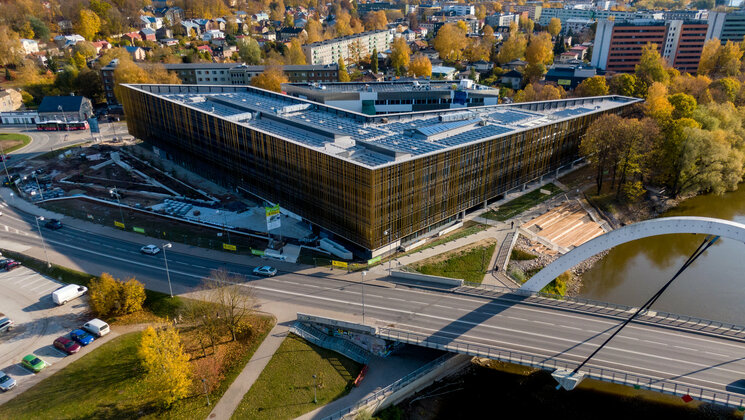-
Faculty of Arts and HumanitiesDean's Office, Faculty of Arts and HumanitiesJakobi 2, r 116-121 51005 Tartu linn, Tartu linn, Tartumaa EST0Institute of History and ArchaeologyJakobi 2 51005 Tartu linn, Tartu linn, Tartumaa EST0Institute of Estonian and General LinguisticsJakobi 2, IV korrus 51005 Tartu linn, Tartu linn, Tartumaa EST0Institute of Philosophy and SemioticsJakobi 2, III korrus, ruumid 302-337 51005 Tartu linn, Tartu linn, Tartumaa EST0Institute of Cultural ResearchÜlikooli 16 51003 Tartu linn, Tartu linn, Tartumaa EST0Institute of Foreign Languages and CulturesLossi 3 51003 Tartu linn, Tartu linn, Tartumaa EST0School of Theology and Religious StudiesÜlikooli 18 50090 Tartu linn, Tartu linn, Tartumaa EST0Viljandi Culture AcademyPosti 1 71004 Viljandi linn, Viljandimaa EST0Professors emeriti, Faculty of Arts and Humanities0Associate Professors emeriti, Faculty of Arts and Humanities0Faculty of Social SciencesDean's Office, Faculty of Social SciencesLossi 36 51003 Tartu linn, Tartu linn, Tartumaa EST0Institute of EducationJakobi 5 51005 Tartu linn, Tartu linn, Tartumaa EST0Johan Skytte Institute of Political StudiesLossi 36, ruum 301 51003 Tartu linn, Tartu linn, Tartumaa EST0School of Economics and Business AdministrationNarva mnt 18 51009 Tartu linn, Tartu linn, Tartumaa EST0Institute of PsychologyNäituse 2 50409 Tartu linn, Tartu linn, Tartumaa EST0School of LawNäituse 20 - 324 50409 Tartu linn, Tartu linn, Tartumaa EST0Institute of Social StudiesLossi 36 51003 Tartu linn, Tartu linn, Tartumaa EST0Narva CollegeRaekoja plats 2 20307 Narva linn, Ida-Virumaa EST0Pärnu CollegeRingi 35 80012 Pärnu linn, Pärnu linn, Pärnumaa EST0Professors emeriti, Faculty of Social Sciences0Associate Professors emeriti, Faculty of Social Sciences0Faculty of MedicineDean's Office, Faculty of MedicineRavila 19 50411 Tartu linn, Tartu linn, Tartumaa ESTInstitute of Biomedicine and Translational MedicineBiomeedikum, Ravila 19 50411 Tartu linn, Tartu linn, Tartumaa ESTInstitute of PharmacyNooruse 1 50411 Tartu linn, Tartu linn, Tartumaa ESTInstitute of DentistryL. Puusepa 1a 50406 Tartu linn, Tartu linn, Tartumaa ESTInstitute of Clinical MedicineL. Puusepa 8 50406 Tartu linn, Tartu linn, Tartumaa ESTInstitute of Family Medicine and Public HealthRavila 19 50411 Tartu linn, Tartu linn, Tartumaa ESTInstitute of Sport Sciences and PhysiotherapyUjula 4 51008 Tartu linn, Tartu linn, Tartumaa ESTProfessors emeriti, Faculty of Medicine0Associate Professors emeriti, Faculty of Medicine0Faculty of Science and TechnologyDean's Office, Faculty of Science and TechnologyVanemuise 46 - 208 51003 Tartu linn, Tartu linn, Tartumaa ESTInstitute of Computer ScienceNarva mnt 18 51009 Tartu linn, Tartu linn, Tartumaa ESTInstitute of GenomicsRiia 23b/2 51010 Tartu linn, Tartu linn, Tartumaa ESTEstonian Marine Institute0Institute of PhysicsInstitute of ChemistryRavila 14a 50411 Tartu linn, Tartu linn, Tartumaa EST0Institute of Mathematics and StatisticsNarva mnt 18 51009 Tartu linn, Tartu linn, Tartumaa EST0Institute of Molecular and Cell BiologyRiia 23, 23b - 134 51010 Tartu linn, Tartu linn, Tartumaa ESTTartu ObservatoryObservatooriumi 1 61602 Tõravere alevik, Nõo vald, Tartumaa EST0Institute of TechnologyNooruse 1 50411 Tartu linn, Tartu linn, Tartumaa ESTInstitute of Ecology and Earth SciencesJ. Liivi tn 2 50409 Tartu linn, Tartu linn, Tartumaa ESTProfessors emeriti, Faculty of Science and Technology0Associate Professors emeriti, Faculty of Science and Technology0Institute of BioengineeringArea of Academic SecretaryHuman Resources OfficeUppsala 6, Lossi 36 51003 Tartu linn, Tartu linn, Tartumaa EST0Area of Head of FinanceFinance Office0Area of Director of AdministrationInformation Technology Office0Administrative OfficeÜlikooli 17 (III korrus) 51005 Tartu linn, Tartu linn, Tartumaa EST0Estates Office0Marketing and Communication OfficeÜlikooli 18, ruumid 102, 104, 209, 210 50090 Tartu linn, Tartu linn, Tartumaa EST0Area of RectorRector's Strategy OfficeInternal Audit OfficeArea of Vice Rector for Academic AffairsOffice of Academic AffairsUniversity of Tartu Youth AcademyUppsala 10 51003 Tartu linn, Tartu linn, Tartumaa EST0Student Union OfficeÜlikooli 18b 51005 Tartu linn, Tartu linn, Tartumaa EST0Centre for Learning and TeachingArea of Vice Rector for ResearchUniversity of Tartu LibraryW. Struve 1 50091 Tartu linn, Tartu linn, Tartumaa EST0Grant OfficeArea of Vice Rector for DevelopmentCentre for Entrepreneurship and InnovationNarva mnt 18 51009 Tartu linn, Tartu linn, Tartumaa EST0University of Tartu Natural History Museum and Botanical GardenVanemuise 46 51003 Tartu linn, Tartu linn, Tartumaa EST0International Cooperation and Protocol Office0University of Tartu MuseumLossi 25 51003 Tartu linn, Tartu linn, Tartumaa EST0
Lung cancer mostly affects men from industrial regions of Ida-Viru County
A study by the researchers of the University of Tartu revealed that in the years 1992–2015, the incidence of lung cancer among men living in the Estonian oil shale industrial regions was higher compared to the rest of Ida-Viru County and the Estonian average: 133.6 in industrial regions and 95.5 in Estonia as a whole per 100,000 men. Other cancer sites did not show any difference in incident rates between Ida-Viru County and the rest of Estonia. On the positive side, the lung cancer incidence rate in industrial regions has been decreasing.
Since the beginning of the 20th century, Ida-Viru County has been the main industrial area of Estonia, focusing on oil shale mining and the production of electricity and shale oil. Industrial activities emit large amounts of air pollutants, many of which are toxic and carcinogenic.
“The air of industrial regions may include particulate matter, benzene, phenols and other pollutants, all of which affect health and increase the risk of cancer,” said Hans Orru, Associate Professor in Environmental Health of the University of Tartu.
Polluted air, soil, and water are a major problem in most industrial areas all over the world. Research articles have described an increasing correlation between living near industrially contaminated sites or exposure to industrial air pollution and the general incidence rate of cancer and cancer-related mortality. The International Agency for Research on Cancer has also confirmed that air pollution and pollutants including particulate matter and benzene increase the risk of cancer.
Cancer is one of the leading causes of death in Europe and worldwide. In 2018, there were 18.1 million new cancer cases globally. The total registered numbers of observed cancer cases between 1992–2015 in Estonia and Ida-Viru County were 51,525 and 6,752, respectively. In Estonia, cancer holds second place among causes of death both in women and men, after cardiovascular diseases.
To get an overview of the incidence rate of different types of cancer in regions affected by oil shale industry and compare it to the general cancer incidence rate and trends in Estonia, researchers of the University of Tartu Faculty of Medicine in cooperation with the Estonian Health Board analysed the data of the Estonian Cancer Registry on selected cancer sites that have been previously indicated to have relationships with industrial processes. The incidence rates of lung cancer, kidney cancer, urinary bladder cancer, breast cancer, leukaemia and non-Hodgkin’s lymphoma in the years 1992–2015 were analysed. The findings have been published in the International Journal of Environmental Research and Public Health.
Lung cancer is the most common
The study revealed that lung cancer incidence rate in males was significantly higher in the industrial region than in Estonia overall. In industrial regions, 133.6 men in 100,000 had lung cancer compared to 95.5 in Estonia overall. The incidence of other types of cancer was similar in the oil shale regions and the rest of Estonia.
According to Hans Orru, one of the explanations for the higher lung cancer morbidity among males in Ida‑Viru County could be associated with industrial pollution. “Several earlier studies have shown that long-term occupational exposure to high levels of exhaust gas is associated with an increased risk of lung cancer, and mining industry machines mostly use diesel fuel. In total, 16% of males in Ida-Viru County are occupied in the oil shale industry, and could therefore be at a higher risk of developing lung cancer,” said Orru. However, as the Estonian Cancer Registry does not record occupational information, the researchers could not analyse the effects of occupational exposures in more detail.
The researchers admit that even more than environmental factors, smoking affects the development of lung cancer. According to the Estonian Health Behaviour Survey, the daily smoking prevalence in males in the 1990s was around 50% and has decreased since 2006. Therefore, an important cause of lung cancer is the habit of smoking, and a majority of males in the oil shale industrial areas of Ida-Viru County is exposed to direct or indirect contact with tobacco smoke every day.
Another lung cancer risk factor prevalent in Ida-Viru County is radon. The main health damage caused by inhaling radon and its degradation products is lung cancer, with 3–20% of all lung cancer cases worldwide being attributable to radon. According to previous research, in one third of the Estonian territory, including Ida-Viru County, the radon risk exceeds the limit considered safe, i.e., 50 kBq/m3. Other explanations to the higher lung cancer incidence could be lifestyle-related factors such as obesity, hypertension and alcohol consumption.
However, in recent decades, the difference in lung cancer incidence rates between Ida-Viru County and the rest of Estonia has been decreasing. Over the years included in the study, the incidence rate for lung cancer in Ida-Viru County decreased by 28.9%. At the same time, it increased significantly in non-oil shale areas (13.3%) and in Estonia overall (1.5%).
The decrease in lung cancer morbidity in Ida-Viru County can be explained by improved environmental quality in that region, as the oil shale mining companies have implemented more environmentally friendly production technologies.
This year's Cancer Awareness Week (5 to 11 October) focused on lung cancer.
Hans Orru
Associate Professor in Environmental Health, University of Tartu
527 7427
hans.orru@ut.ee
Read more similar news






